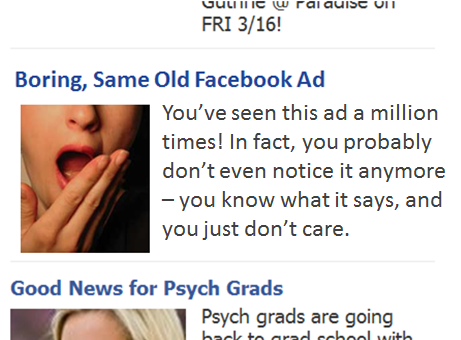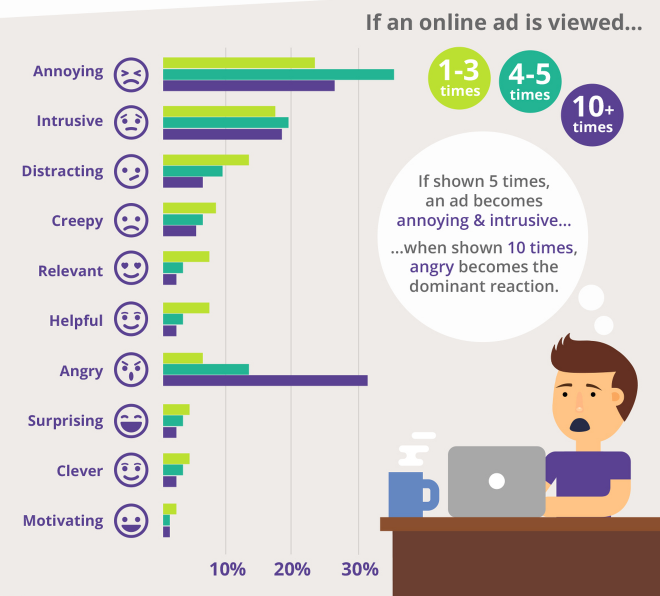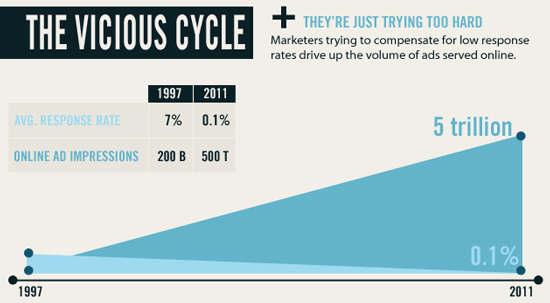In the past few years, marketers have gained targeting insights they could only dream about decades ago. Data has been essential in shaping messaging, delivering advertisements, and driving sales. The digital advertising ability to target by narrow interests or demographics seems like the most practical and effective solution to the marketing woes of the past. Serving your message only to interested people in the market may seem like the most logical use of advertising dollars. Unfortunately, there comes a point that too much becomes a bad thing and can negatively impact your brand and sales.
Here’s What You Might be Doing Wrong:
Cutting Creative
Although it may be cheaper to only have one or two variations of creative, this can actually be more hurtful to marketing efforts than cost-effective. Facebook is one platform where ad fatigue is very common. Ads are frequently delivered across smaller target audiences within the platform. When these ads go unchanged or only have one variation, the audience begins to ignore the ads at a rapid rate.

A simple fix to this problem is to frequently swap out old creatives and introduce new creatives to the campaign. Simple image changes can go a long way and can greatly minimize the ad fatigue consumers experience. Make sure the images you select are engaging and run testing to find what types of images your consumers respond the most to. Keep in mind that even a “perfect” Facebook ad is vulnerable to ad fatigue.
Digital Specialist Megan says: “In my opinion, one of the best ways to counteract ad fatigue is to create a testing schedule. Take your best-performing creative and test it against your new creative. Doing this will get you great results to use when building the next round of creative.”
Thinking Too Narrow
In addition to overused old creative, the frequency of your ads has a high impact on user perceptions and ad effectiveness. If you narrow your target too small, you run the risk of showing the same people your ad too frequently. The below graphic illustrates what happens when people see an ad or other pieces of content too many times. At first, they may view the ads as helpful or relevant, but after 10 views of the same ad, they can become angry and annoyed.
One study from the Advertising Research Foundation found early this year that if a person views a digital banner ad more than 40 times in a month, sales start to decline. The overkill actually rendered many of the viewable impressions worthless or counterproductive. Mobile ads also run the risk of quickly diminishing in value because they can often reach their targets at lower costs. Just because you can serve someone an ad 80 times in one month, doesn’t mean you should. If you are seeing CTR’s quickly drop off, it may be time for you to rethink your target or back off the frequency that you are showing your ads.
Digital Specialist Tobaria says: “One of the problems that occurs when you narrow your audience down too much is that you lose all the scale that a broader audience provides. For example, trying to target people who workout at a certain gym between the hours of 2 and 4 PM on a Wednesday will significantly reduce the amount of people you will be able to reach.”
Disproportional Budgets
This may sound crazy, but allocating too much money to a single tactic or target audience could also lead to negative exposure and decreasing sales. If you cut costs in the creative department and heavily load your media budget for Facebook, chances are people are going to get worn out pretty quickly. The best strategy is to have a variation of not only creative but in tactics and targeting as well. Even if you know that the majority of your target market lies on Facebook, branching out to different tactics or staggering creative will prove beneficial to you. Marketing Evolution CEO Rex Briggs also suggests that “once they’ve inundated their core target, spend perhaps less efficiently to reach a broader audience that still contains potential brand buyers” is a good strategy for brands who may be stuck spending too much for one target.
Digital Specialist Luke says: “People don’t visit only one website, so why should you limit yourself in targeting only one type of media?”
Lack of Testing
The final thing that we see people doing that can negatively impact their marketing efforts is a lack of testing. Testing doesn’t only have to be for copy and images, but can also apply to target audiences and tactics. It is common that a brand may think they know their target audience perfectly from the start, but often we see that this audience may not be the perfect fit for an online marketing campaign. It’s important to test out multiple audiences across platforms and optimize to the audience that performs the best.
Digital Specialist Ashley says: “Continuous testing helps determine how effective campaigns are and if you’re getting the most bang for your buck. Without testing, you could be missing out on a lot of opportunities to reach potential audiences.” If you want to learn more about the importance of testing, check out Ashley’s blog post “Test, Test, and Test Again“.
All in this Together
In order to maximize the effectiveness of your marketing efforts, you must not just fix one of these problem areas, but work towards avoiding all four. Creative should be kept fresh and new and be tested frequently. The target audience should be small enough to be effective, but not too narrow that a small amount of people are bombarded with the same advertisements daily. Your advertising dollars should be spent more evenly across digital platforms and in proportion to creative development. Finally, you should always be testing out different tactics as well as target audiences to make sure you are always staying current in front of your future customers. Digital advertising has a lot of benefits when it comes to targeting, make sure you are using them for good.

